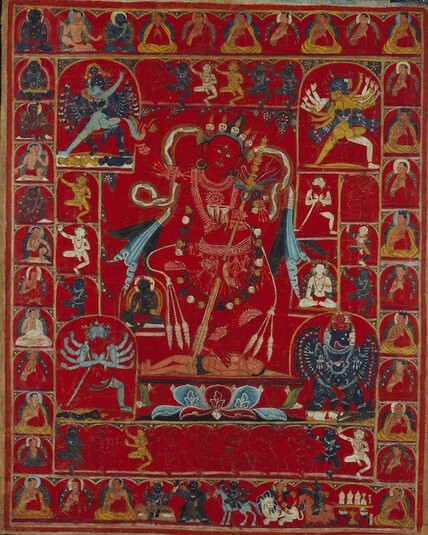
Item: Vajrayogini (Buddhist Deity) - (Dancing Posture)
| Origin Location | Tibet |
|---|---|
| Date Range | 1300 - 1399 |
| Lineages | Kagyu, Karma (Kagyu) and Buddhist |
| Material | Ground Mineral Pigment on Cotton |
| Collection | Private |
Classification: Deity
Appearance: Semi-Peaceful
Gender: Female
Vajrayogini (Tibetan: dor je phag mo lha nga): principal meditational deity of the Six Dharmas of Naropa. (See HAR #23512).
Sanskrit: Vajrayogini Tibetan: dor je nal jor ma
Tibetan: dor je nal jor ma
Sanskrit:  Tibetan:
Tibetan: 
With a fierce expression, slightly peaceful and slightly wrathful, she is red in colour with one face, three eyes and dark yellow hair tied to the crown of the head. The right hand holds aloft a curved flaying knife with a gold vajra handle and the left to the heart a white skullcup. In the bend of the left elbow stands an upright tantric katvanga staff, ornate with blue and red streamers. Adorned with a tiara of gold and five white skulls, ribbons and gold earrings, a garland of fifty fresh heads, a bone necklace, girdle, bracelets and anklets, she wears a long scarf around the shoulders - blue and green in colour. With the right leg raised in a dancing posture, the left presses on a prone figure. Above a sun disc and lotus seat, she is completely surrounded by the curling flames of red pristine awareness fire.
At the upper left is blue Hevajra and Nairatmya. At the upper right is blue and white Kalachakra embracing yellow Vishvamata. At the lower right is blue Vajrabhairava who stands without a consort. At the lower left is Chakrasamvara embracing Vajrayogini. Between these four deities, in vertical and horizontal registers, are various attendant goddesses and dakinis.
To the immediate right side of the central Vajrayogini is a small figure of White Chakrasamvara embracing a red Yogini. Below that is White tara and on the left side of Vajrayogini is a small figure of Green Tara.
The top register and the vertical right register depict the teaching lineage of Vajrayogini. It begins at the top left and follows in a clockwise fashion. There are five teachers in the lineage that bear the black hat of the Karmapas. The last of them is likely to be the 5th Gyalwa Karmapa, Deshin Shegpa (1384-1415).
The left side vertical register contains the Eight Great Mahasiddhas along with a few extra lineage teachers at the bottom connecting to the bottom register with three teachers on the left side. There are five protector figures in the middle of the bottom register. They are eft to right: Chaturbhuja Mahakala, Bhagavan Mahakala (legden), Shri Devi, Vaishravana Riding a Lion, and Damchen Garwa Nagpo.
Vajrayogini is the principal female deity of the Chakrasamvara Cycle of Tantras. Vajrayogini is the main female deity and there are many forms each having a unique name and appearance. Some names are descriptive such as Krodha Kali meaning 'black wrathful' yogini and others refer to the lineage or principal Indian mahasiddha associated with a particular Yogini practice. The most common forms found in art are the Naropa (Naro Khacho) form, Vajravarahi (with the pig face at the side), Krodha Kali (the black form) and Dechen Gyalmo (of the Longchen Nyingtig).
There are many other forms of the deity besides those mentioned above but the others are not found as often in art as a central subject or sculpture. There are also many different mandala configurations for the various forms of Vajrayogini.
Vajrayogini, is a representation of complete buddhahood in female form. Classified as Wisdom or 'Mother' Anuttarayoga Tantra the practices originate with the Chakrasamvara Cycle of Tantras. Although found in a variety of forms, she is common to all schools of Tibetan Buddhism. In this particular form she is a special teaching passed down from the lineage of the Indian mahasiddha Naropa through to the Sakya School. This form is also popular within the Gelug Tradition.
Jeff Watt 7-2013
Buddhist Deity: Vajrayogini, Dancing Posture
Subject: Protector Deities, Tibetan (Prior to 17th Century)
Buddhist Deity: Vajrayogini (Early Paintings)
Collection: Christie's, July New Additions

